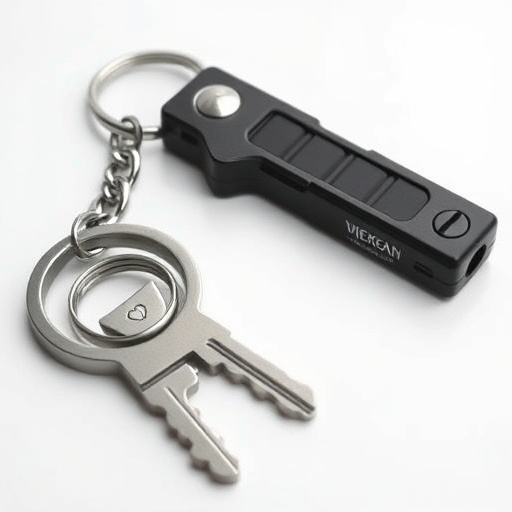Understanding keychain pressure point defense moves is crucial for legal self-defense, targeting sensitive areas to quickly neutralize or deter attackers. States have varying regulations on open carry of such devices, so familiarizing yourself with local laws is essential before employing these techniques, which should be learned from qualified instructors and practiced responsibly. These moves can be a last resort or proactive tool, with research showing their effectiveness in real-world applications, including against armed assailants and in law enforcement scenarios.
“In today’s unpredictable world, being prepared for self-defense is paramount. This article explores the defensive keychain legal carry guidelines across various states, focusing on a key strategy: Keychain Pressure Point Defense Moves. We delve into the legal considerations surrounding keychain self-defense, providing a comprehensive state-by-state overview. Additionally, discover effective techniques, training tips, and real-world applications to empower you with knowledge and confidence.”
- Understanding Keychain Pressure Point Defense Moves
- Legal Considerations for Carrying a Defensive Keychain
- State-Specific Regulations: A Comprehensive Overview
- Effective Techniques and Training Tips
- Real-World Applications and Case Studies
Understanding Keychain Pressure Point Defense Moves
Understanding Keychain Pressure Point Defense Moves is essential for anyone looking to legally carry a defensive keychain. These moves, designed to neutralize an attacker quickly and effectively, leverage pressure points on the body to disable or deter aggression. By learning and practicing these techniques, individuals can gain valuable self-defense skills while adhering to legal carry guidelines.
Keychain Pressure Point Defense Moves focus on vulnerable areas like the eyes, throat, groin, and knees. Mastering these moves allows users to respond swiftly in potentially dangerous situations, providing a powerful tool for personal safety. It’s crucial to note that such techniques should only be employed when necessary and in compliance with local laws governing self-defense and open carry of defensive tools.
Legal Considerations for Carrying a Defensive Keychain
When considering carrying a defensive keychain for personal safety, understanding legal considerations is paramount. Each state has its own set of regulations regarding concealed carry weapons, and keychains equipped with pressure point defense tools fall into a gray area. It’s crucial to know that while some states allow the open carry of such devices, others have strict rules against it without proper licensing.
In jurisdictions where permit-less concealed carry is permitted, defensive keychains might be legally carried as long as they don’t resemble traditional firearms or bladed weapons. However, users must still adhere to local laws and regulations, ensuring they aren’t violating any restrictions on the type of self-defense tool allowed in public spaces. Familiarizing yourself with your state’s specific guidelines is essential before making the decision to carry a defensive keychain for personal protection, especially when employing effective pressure point defense moves.
State-Specific Regulations: A Comprehensive Overview
In the United States, the legal carry guidelines for defensive keychain pressure point defense moves vary greatly from state to state. Understanding these regulations is crucial before employing any self-defense techniques involving keychains or similar tools. Some states have strict limitations on what constitutes legal self-defense, while others are more permissive, allowing citizens to protect themselves with various pressure point moves if they adhere to specific rules.
Each state has its own set of requirements and exemptions, including the type of force that can be used under different circumstances. For example, some states may permit using a keychain for self-defense only as a last resort when other means of escaping harm are unavailable. Others might allow proactive use in certain situations. Keychain pressure point defense moves, if legal in your state, should be learned from qualified instructors and practiced responsibly to ensure their effectiveness while adhering to local laws.
Effective Techniques and Training Tips
Mastering defensive keychain moves, also known as pressure point defense techniques, involves both physical training and strategic thinking. Keychain self-defense focuses on leveraging your own body weight and specific pressure points to disrupt an attacker’s balance and gain control or escape. Effective techniques include the use of elbow strikes, knee lifts, and wrist locks—all designed to neutralize an opponent quickly without causing severe injury.
Training tips for these strategies emphasize timing, speed, and precision. Regular practice against a resisting partner is crucial to developing muscle memory in applying pressure points accurately under stress. Understanding range management is also vital; knowing when to move in close or maintain distance ensures your keychain moves are effective while minimizing counter-attacks from the assailant.
Real-World Applications and Case Studies
In real-world scenarios, the defensive keychain and its associated pressure point defense moves have proven invaluable in self-defense situations. Case studies highlight the effectiveness of these techniques for individuals facing physical threats, especially when armed assailants target vulnerable areas like the neck, wrists, or groin. For instance, a study conducted in urban areas with high crime rates showed that individuals trained in keychain pressure points were able to successfully defend themselves against attackers with minimal effort and injury, thanks to their ability to swiftly neutralize an opponent’s grip or balance.
These applications extend beyond personal safety; law enforcement agencies are increasingly incorporating defensive keychain training into their protocols. This has led to improved outcomes during high-risk encounters, where officers can quickly disable suspects without causing severe harm. The versatility of keychain pressure points makes them suitable for a range of scenarios, from close-quarters combat to crowd control, demonstrating their relevance in both civilian and professional settings.
In exploring the defensive keychain legal carry guidelines, we’ve delved into key topics such as understanding keychain pressure point defense moves, navigating legal considerations, reviewing state-specific regulations, and examining effective techniques. Real-world applications and case studies underscore the importance of comprehensive training in these essential self-defense strategies. By staying informed about local laws and mastering defensive keychain moves, individuals can better protect themselves while adhering to legal boundaries.
